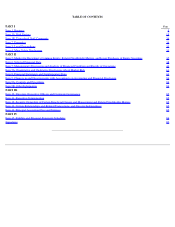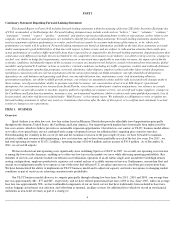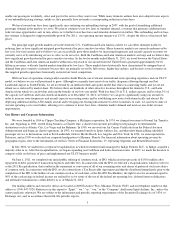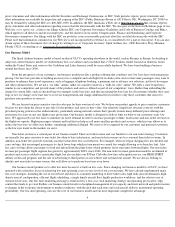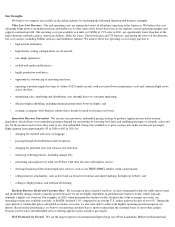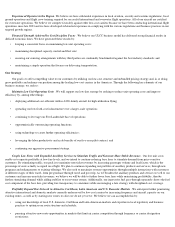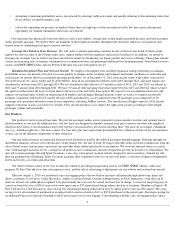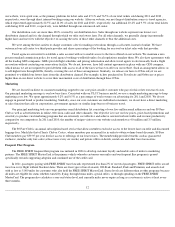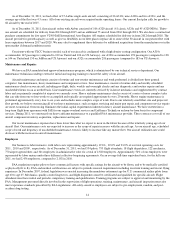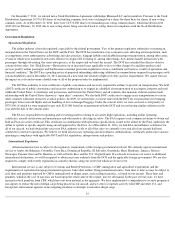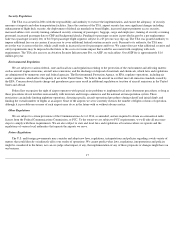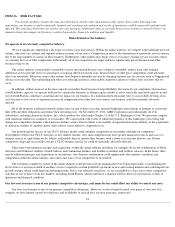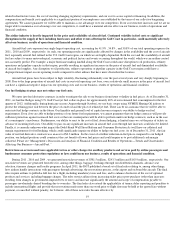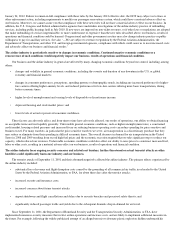Spirit Airlines 2011 Annual Report Download - page 14
Download and view the complete annual report
Please find page 14 of the 2011 Spirit Airlines annual report below. You can navigate through the pages in the report by either clicking on the pages listed below, or by using the keyword search tool below to find specific information within the annual report.
As of December 31, 2011, our highest volume U.S. domestic routes that provide leisure traffic to South Florida and, through our South
Florida gateway, to our Latin and Caribbean markets, were New York LaGuardia, Washington Reagan, Chicago O’Hare, Atlanta, and Atlantic
City.
Our network expansion targets underserved and/or overpriced markets. We utilize a rigorous process to identify growth opportunities to
deploy new aircraft where we think they will be profitable. To monitor the profitability of each route, we analyze weekly and monthly
profitability reports as well as near term forecasting.
Competition
The airline industry is highly competitive. The principal competitive factors in the airline industry are fare pricing, total price, flight
schedules, aircraft type, passenger amenities, number of routes served from a city, customer service, safety record and reputation, code-sharing
relationships, and frequent flier programs and redemption opportunities. Our competitors and potential competitors include traditional network
airlines, low-cost carriers, regional airlines and new entrant airlines. We typically compete in markets served by traditional network airlines and
other low-
cost carriers, and to a lesser extent regional airlines. Some of our current or future competitors may have greater liquidity and access to
capital, and serve more routes, than we do.
Our principal competitors on domestic routes are American Airlines, Delta Air Lines and JetBlue Airways. Our single largest overlap, at
approximately 60% of our markets as of February 10, 2012, is with American Airlines. Southwest Airlines and AirTran Airways merged in May
2011, but continue to operate as separate carriers. Our principal competitors for service from South Florida to our growth markets in the
Caribbean and Latin America are American Airlines through its hub in Miami and JetBlue Airways through its operations in Fort Lauderdale.
Our principal competitive advantages are our low base fares and our focus on the price-sensitive traveler who pays his or her own travel costs.
These low base fares are facilitated by our low unit operating costs, which in 2011 were lower than any of the four major network carriers and
lower than the three largest low-cost carriers. We believe our low costs coupled with our non-
ticket revenues allows us to price our fares at levels
where we can be profitable while our primary competitors cannot. Further, we believe we compete favorably with other low-cost carriers in
serving the Caribbean and Latin America because we have been conducting international flight operations since 2003 and have developed
substantial experience in complying with the various regulations and business practices in those targeted growth regions.
The airline industry is particularly susceptible to price discounting because once a flight is scheduled, airlines incur only nominal
incremental costs to provide service to passengers occupying otherwise unsold seats. The expenses of a scheduled aircraft flight do not vary
significantly with the number of passengers carried and, as a result, a relatively small change in the number of passengers or in pricing could
have a disproportionate effect on an airline’s operating and financial results. Price competition occurs on a market-by-market basis through price
discounts, changes in pricing structures, fare matching, target promotions and frequent flier initiatives. Airlines typically use discount fares and
other promotions to stimulate traffic during normally slower travel periods to generate cash flow and to maximize RASM. The prevalence of
discount fares can be particularly acute when a competitor has excess capacity that it is under financial pressure to sell. A key element to our
competitive strategy is to maintain very low unit costs in order to permit us to compete successfully in price-sensitive markets.
Many airlines have marketing alliances with other airlines, under which they market and advertise their status as marketing alliance
partners. Such alliances generally provide for code-sharing, frequent flier program reciprocity, coordinated scheduling of flights to permit
convenient connections and other joint marketing activities. Such arrangements permit an airline to market flights operated by other alliance
members as its own. This increases the destinations, connections and frequencies offered by the airline, which provide an opportunity to increase
traffic on that airline’s segment of flights connecting with alliance partners. Competitors that are alliance members with carriers that have
designated route and frequency rights in restrictive markets, such as some of the markets we serve in the Americas, often are able to compete
advantageously with non-alliance carriers because they can use their code-share arrangements to effectively limit the ability of non-alliance
carriers to increase available seat capacity or frequencies in a particular market. Low-cost carriers have not historically been members of any of
the three major alliances, OneWorld, SkyTeam and Star Alliance. Similarly, regional airlines typically enter into cooperative marketing
relationships with one or more major airlines under which the regional airline agrees to use its smaller, lower-cost aircraft to carry passengers
booked and ticketed by the major airline between a city served by a major airline and a smaller outlying location. We currently do not have any
alliances or cooperative marketing relationships with U.S. or foreign airlines.
Distribution
As of December 31, 2011, we sold our product through three primary distribution channels: our website, our outsourced call center, and
third parties such as travel agents who access us through the Global Distribution System or GDS companies (e.g., Amadeus, Galileo, Sabre and
Worldspan) and select online travel agents, or OTAs (e.g., Orbitz and Travelocity). We use
11


